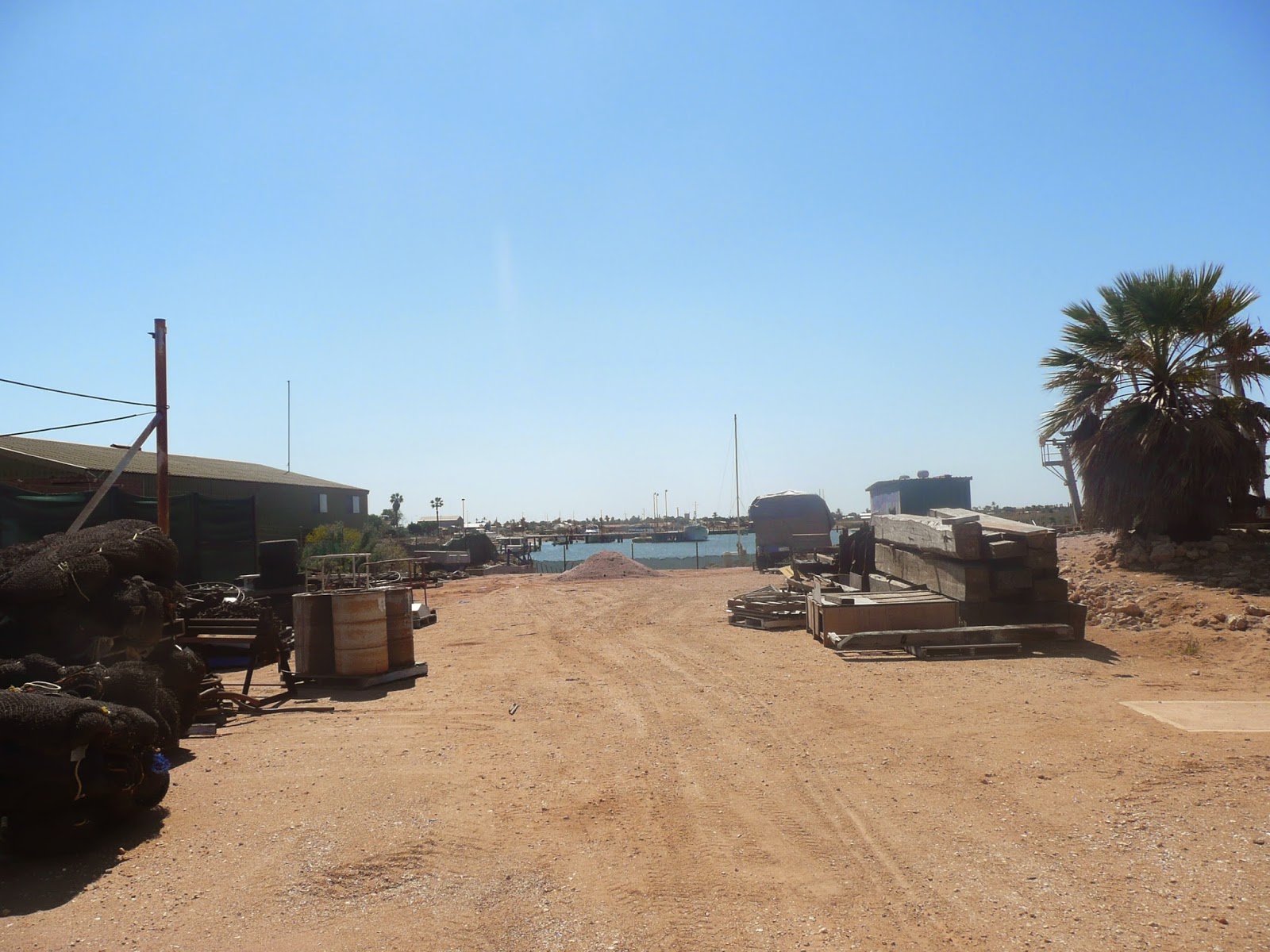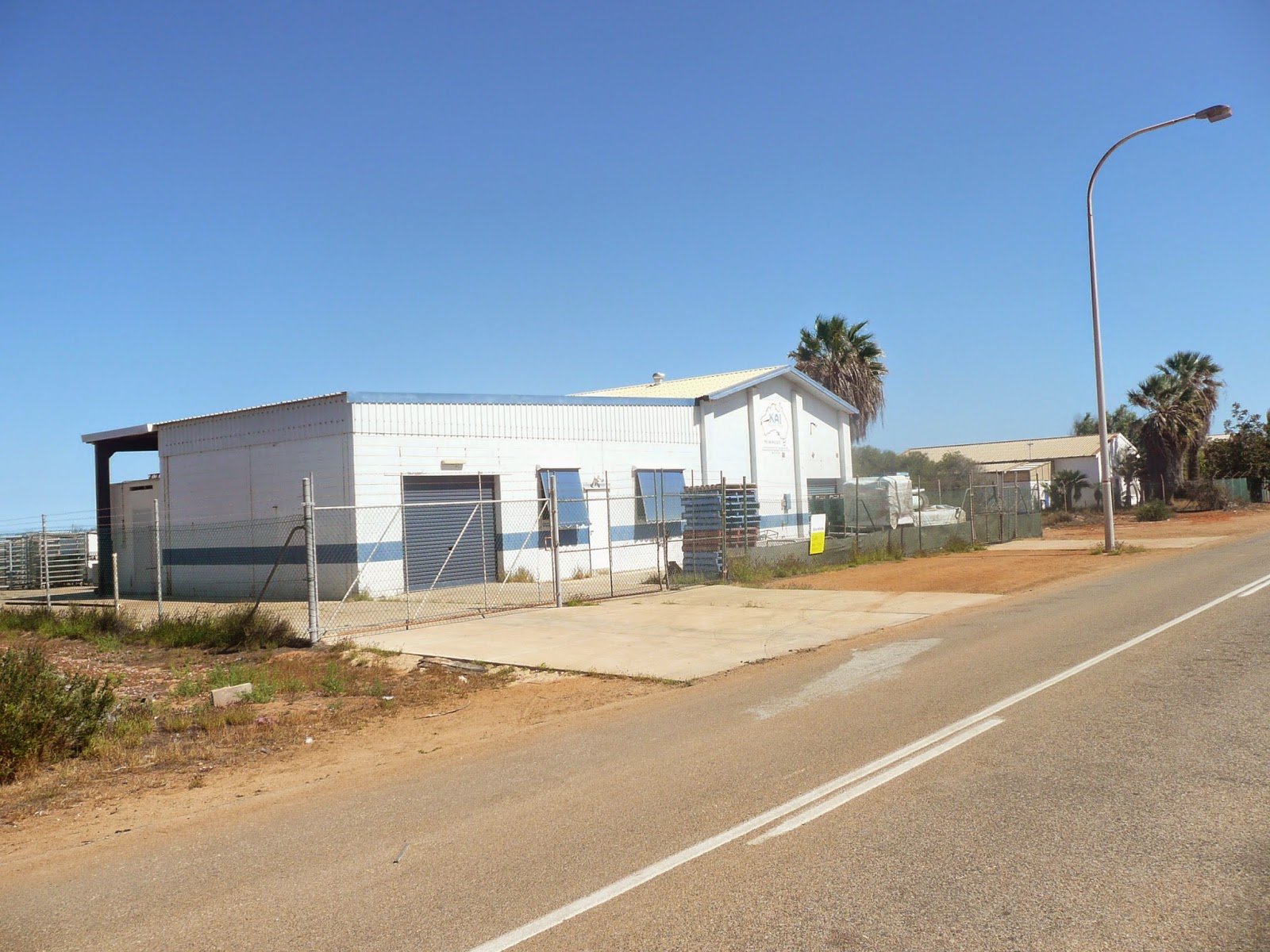As you have now seen and read, the Carnarvon economy is heavily reliant on fruit and vegetable production, but fishing is also a significant local industry. The fishing boat harbour was next on our visiting list.

The harbour precinct with its protected basin and surrounding infrastructure is accessed along the logically named Harbour Road. Before reaching that I drove past the Carnarvon Yacht Club building
and another of Carnarvon's Motels
before reaching the junction of Harbour Road and its sign of welcome.
Off to the left of the road mangrove flats extend for quite some distance in a scene which is 'typical Carnarvon'.
In another effort to provide some perspective of this area of Carnarvon I have again 'borrowed' this aerial shot from the Internet. Let me add some explanations.
Harbour Road runs along the narrow neck of land which separates the mushroomed shaped fishing boat harbour and its dredged entrance channel from the southern arm of the Gascoyne. Mid-right in the photo we can see the darker green of the Carnarvon CBD and its immediate surrounds which, at the western end, abuts the curved waterway of the Fascine. The Babbage Island causeway to the One Mile Jetty runs along the barren looking strip of land at the upper left of the shot. Pelican Point lies just out of shot to the left on the far bank of the Gascoyne.
I hope this makes sense and demonstrates again some of the complexity of the waterways beside which Carnarvon has been built and the fact that getting from one part of town to another is not always straightforward.
I hope this makes sense and demonstrates again some of the complexity of the waterways beside which Carnarvon has been built and the fact that getting from one part of town to another is not always straightforward.

Recreational fishing is 'big business' in Carnarvon. Like most places along this coastline those wishing to venture beyond the sheltered confines of the Fascine, the northern arm of the Gascoyne, the boat harbour or nearby Oyster Creek,
where tinnies are the order of the day (such as this little yellow fellow fishing into the mangroves at the top end of the boat harbour),
serious boats are necessary for both safety and comfort. There was not a single axle boat trailer to be seen here at the boat ramp car park.

Past the recreational boat ramp, we come to the real business of this area of Carnarvon....the first of the industrial marine services buildings. This is one of many along Harbour Road.
The boat harbour itself is not huge, but does provide a safe mooring for a variety of vessels.
Whilst the main purpose of this harbour is to cater for the Carnarvon fishing fleet,
many other vessels make the most of the calm waters, such as this magnificent old ketch,

a large Japanese fishing boat

and an interloper, a cray boat from Lancelin, a fishing town some 600 kms to the south. This is typical of the craft we have seen at Cervantes, Kalbarri, Geraldton and Port Denison where the emphasis is on the capture of the western rock lobster.
But north of Shark Bay, the fishing fleets target prawns and scale fish, and do so with gusto. On the south-western side of the harbour the trawler fleet congregates at wharves adjacent to the
large seafood processing factories on this side of the basin. There were only two of the fleet in port on the day of my visit,

but there are many more based here in Carnarvon as this Internet photo shows.

Panning slightly to the left from the trawler boat moorings, we can see the upper end of the channel which allows the craft access to the Indian Ocean through the mangrove flats.

But all was not well with the entire fleet. The day before our meander around the harbour, this fishing boat lit up the night sky as it became the victim of an on board fire. Oddly enough, access to the hulk was blocked by a line of Police tape....the arson squad were on their way. We are still awaiting the outcome of their investigations.

So, after wandering off Harbour Road to take in the views of the harbour itself and the vessels moored there, it was back to the blacktop where we found more large industrial sheds of all sizes and purpose. But sandwiched between several of them is the Harbourside Cafe, a venue which presents the ostensibly odd mixture of seafood and Indian food. We've not dined there, but have heard good reports. It probably comes as no surprise to learn that the proprietors are from the sub-continent.

Water views are supposed to be part of the dining experience here at the Harbourside, but from what we could see these are less than inspiring as we gazed across this barren bank of the southern Gasconye to the distant Pelican Point resort. But, by all account, the food is very good. I'm still trying to persuade the treasurer to loosen the purse strings one evening (for the seafood, that is..I'm still allergic to curries)

Almost next door is the Crabshack, an establishment dedicated to the sale of seafood of all varieties, both scale and shell. They occasionally e-mail the park, advertising prawn specials. I did respond to one such invitation, and whilst the product was good enough, we both remain dedicated to the superior quality of the SA gulf prawns, the equal of which we have yet to discover.
I somewhat foolishly (with the benefit of hindsight) expressed that point of view to the proprietress of the Crabshack to be met with a very waspish and highly parochial response. But this is an area where I am sure of my subject...I stood my ground. We agreed to disagee!
As for the fish on offer.....bring you cheque book. Over $50.00 a kilo for locally caught pink snapper is ridiculous. As we discovered in Exmouth, there is no ability to purchase direct from the fishing boats along this coast. Travellers to this part of the world who arrive expecting to enjoy some of the local seafood bounty at less than top price are doomed to disappointment.

Beyond the Crabshack and the large boat yard next door

Harbour Road turns to the left. On the bend are the radio tower and buildings of the Carnarvon Volunteer Sea Rescue group, one of a dedicated band of volunteers found all along the Australian coast, volunteers to whom many owe their lives after being rescued at sea.

Seafood processing factories line both sides of the end of Harbour Road. By far the largest is Kel Brown's Nor-West Seafoods

where rolled nets and other nautical bits and pieces lie alongside the roadway past the processing plant to the fleet docks.

The much more appealing looking building of the Kai company opposite shows that Brown is not having things all his own way.

Our jaunt along Harbour Road ended at the large car park from which we could look out over the mangroves to the harbour entrance channel.

and also across the scrub to the point, some short distance north of the channel entrance, where the southern arm of the Gascoyne meets the sea.

Whilst taking in these views, I spotted a track leading down towards the channel. The temptation was too much. We were off.....
down through the mangroves

to the sandy track alongside the water of the channel where the nervousness of the navigator demanded a premature halt before I could 'give the cruiser its head'. Having said that, we did have a later adventure in this neck of the woods...all will be revealed in due course.

Despite the forced halt on our march towards the sea, this vantage point did allow us to look north-east back along the channel to the boat harbour
and, with a turn of 180 degrees, the red and green lateral markers of the channel passage as it
meets the Indian Ocean come into view. The sandy banks of this side of the channel excited my piscatorial ambitions. "This looks like a fine spot from which to cast a line", I thought. Indeed it is...the story later!
And so we came to the end of our visit to the boat harbour and its surrounds. I do like these places. As I have said before, "you can take the boy out of Port Lincoln but you cannot take Port Lincoln out of the boy". Fishing boats, harbours, waterways and a good fishing venue. What's not to like?












No comments:
Post a Comment